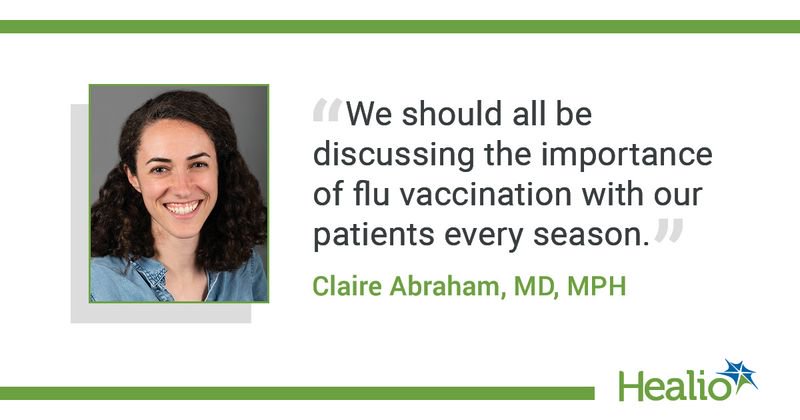Mandates help boost pediatric flu vaccination rates, study finds
Key takeaways:
- Since 2018, fewer than 64% of eligible children have been vaccinated against influenza each season.
- Previously vaccinated children had a lower probability of receiving a vaccine if they lived in a county with high COVID-19 severity.
Vaccine mandates played a significant role in boosting influenza vaccination rates during the 2020-2021 influenza season, researchers reported in Pediatrics.
Claire Abraham, MD, MPH, a pediatrician at the Children's Hospital Primary Care Center at Boston Children’s Hospital, told Healio that the study was inspired by an interest in the policies and environmental factors that impact people’s vaccination behaviors.

“It’s well established that vaccinating children against influenza decreases flu-related morbidity and mortality, as well as community spread,” Abraham told Healio. “However, in the past 5 years, fewer than 64% of eligible children have been vaccinated each season.” “When Massachusetts announced a flu vaccine mandate, it seemed like a great natural experiment to see if such an approach might change vaccination uptake,” Abraham said.
Abraham and colleagues used insurance claims data from a regional insurer to examine influenza vaccination practices across the 2019-2020 and 2020-2021 seasons among 71,333 children in Massachusetts, New Hampshire and Maine aged between 6 months to 18 years.
“Using an individual-level logistic regression model, we assessed whether living in a state with an influenza vaccine mandate or community COVID severity predicted influenza vaccine uptake in the 2020-2021 influenza season and whether these effects differed based on a child’s prior influenza vaccination status,” Abraham said.
Ultimately, the researchers found that children living in states with vaccine mandates during the 2020-2021 influenza season had a higher predicted probability (47.7%) of receiving an influenza vaccine than those living in states without a mandate (21.2%).
For families who vaccinated their children in years prior and who lived in areas with elevated COVID-19 numbers during the 2020-2021 influenza season, however, previously vaccinated children had a lower probability of receiving an influenza vaccine if they lived in a county with the highest COVID-19 severity (72.1%) compared with a county with low COVID-19 severity (77.3%).
“It was interesting to see how significantly a flu vaccine mandate increased vaccination rates, especially among those who had not been vaccinated in the prior season,” Abraham said. “Prior nonvaccinators living in a state with a vaccine mandate had a 26.5% higher predicted probability of receiving a flu vaccine in 2020-2021 than prior nonvaccinators living in a state without a mandate. This was a significantly larger effect than that seen in prior vaccinators. To me this highlighted how many people are willing to vaccinate in certain circumstances, particularly when given clear reasons to do so, even if they don’t always vaccinate against the flu.”
according to the researchers, reasons for lower rates included avoiding in-person clinic visits based on fear of COVID-19 exposure, inability to schedule appointments because of limited availability of in-person office visits or lack of options for a vaccination if a school service shut down with the switch to remote learning.
Understanding how the COVID-19 response and mandate policies affected changes in decision-making about influenza vaccination — particularly for previously unvaccinated children — might be able to inform the development of future strategies to increase youth vaccination rates for influenza and other infectious diseases like COVID-19.
“We should all be discussing the importance of flu vaccination with our patients every season, regardless of whether they accepted or declined a flu vaccine in prior seasons,” Abraham said.
Abraham also cautioned that such mandates are not a catch-all solution.
“It's also important to note that even in a state with a vaccine mandate, the predicted probability of flu vaccination among prior nonvaccinators remained below 50%,” Abraham said. “So, while mandates are an effective way to increase vaccination rates, they aren’t a perfect solution.”
Future studies, she said, should examine how this affects families down the road.
“Further work is needed to enhance communication and policy strategies incentivizing hesitant caregivers to consistently vaccinate children against influenza,” Abraham said. “Separately, future studies are needed to assess the downstream effects of the COVID pandemic on family decisions about influenza vaccination.”
